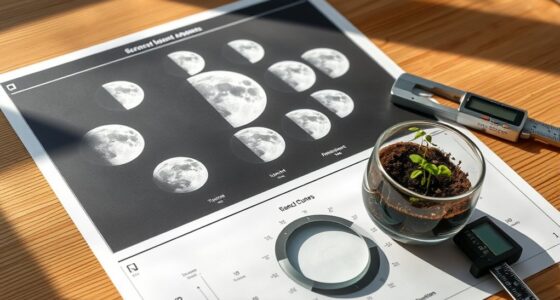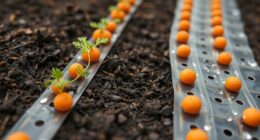Biophotons are faint light emissions that originate from leaf surfaces, caused by internal biochemical processes and environmental interactions. Using sensitive instruments like photomultiplier tubes, scientists detect these tiny light bursts, which encode information about plant health, stress, and communication. These emissions help plants respond quickly to threats and adapt to their surroundings. If you want to explore how biophoton signals reveal plant liveliness and resilience, keep exploring further.
Key Takeaways
- Biophotons are faint light emissions naturally produced by leaf surfaces during biochemical reactions.
- Sensitive detection instruments capture biophotons emitted from leaves, revealing internal plant processes.
- Emission patterns from leaves vary with stress, health status, and environmental conditions.
- Biophoton emissions facilitate intra-plant communication and environmental response signaling.
- Monitoring leaf biophoton emissions offers non-invasive insights into plant vitality and stress levels.
What Are Biophotons and How Are They Detected?

Biophotons are tiny bursts of light emitted by living organisms, including humans, plants, and bacteria. These emissions are incredibly faint, making detection challenging. Scientists use sensitive instruments to measure biophotons through photon counting, which involves detecting individual light particles. Quantum coherence plays a role here, as it suggests that biophoton emissions might be organized at the quantum level, enhancing their detectability. When you use specialized photomultiplier tubes or high-sensitivity cameras, you can observe these faint signals. Photon counting technology allows researchers to quantify biophoton emissions precisely, revealing patterns that might relate to biological processes. Understanding how biophotons are emitted and measured opens a window into the subtle energy exchanges within living systems, providing insights into their health and functioning. Additionally, vibrational energy associated with biophoton emissions may influence cellular communication and overall vitality, and ongoing research explores how these emissions could be linked to biological rhythms. Exploring the measurement techniques further advances our understanding of the complex interactions involved in biophoton emission and their potential applications in health diagnostics.
The Science Behind Light Emissions From Plants
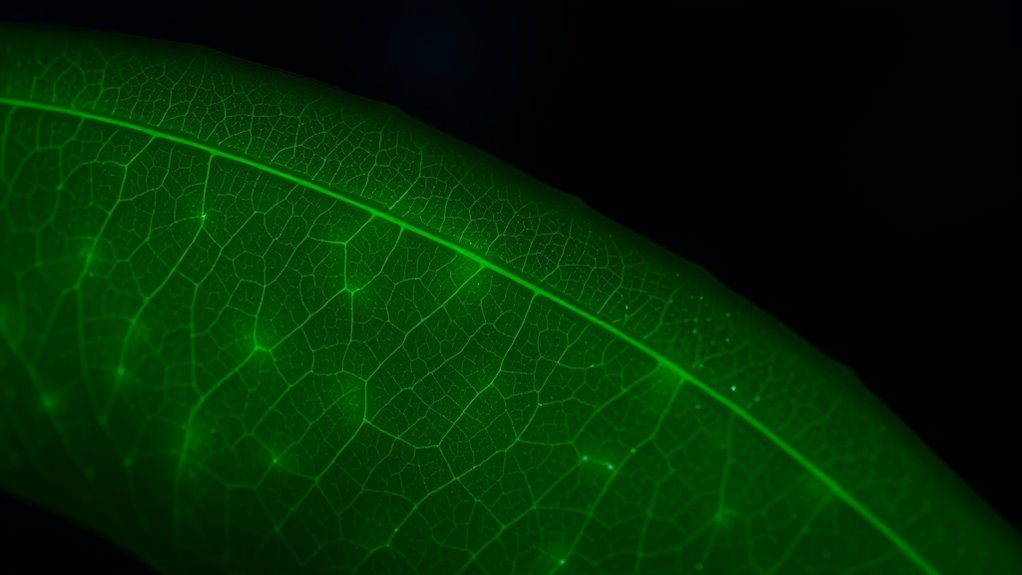
Living organisms, including plants, emit faint bursts of light due to internal biochemical processes. This bioluminescence results from reactions involving molecules like luciferin and enzymes such as luciferase. In plants, light emission is closely tied to plant photoreceptors that detect and respond to light signals. These photoreceptors, like phytochromes and cryptochromes, help plants perceive environmental cues. When these molecules absorb light, they trigger a cascade of light signaling pathways, influencing growth and development. You can imagine a leaf surface glowing subtly as these biochemical reactions occur. Visualize:
Plants subtly glow through internal biochemical reactions involving light-sensitive molecules and photoreceptors.
- Light signaling activating plant responses
- Plant photoreceptors sensing specific wavelengths
- Biochemical reactions producing biophotons
- The connection between internal processes and external light emission
This intricate process explains how plants generate and utilize light emissions in their complex biological systems. Additionally, understanding light signaling pathways offers insights into plant adaptation and communication mechanisms. Moreover, recent research suggests that biophoton emissions may play a role in plant signaling beyond visible light, contributing to their ability to communicate and adapt to environmental changes. Furthermore, exploring biophoton generation can reveal new aspects of plant physiology and their interaction with the environment. Recent studies also indicate that internal biochemical reactions are fundamental to the production of biophotons and their functions in plant systems. It is fascinating to consider how these subtle light emissions might serve as a form of plant communication at a cellular or systemic level.
Roles of Biophotons in Plant Communication and Health
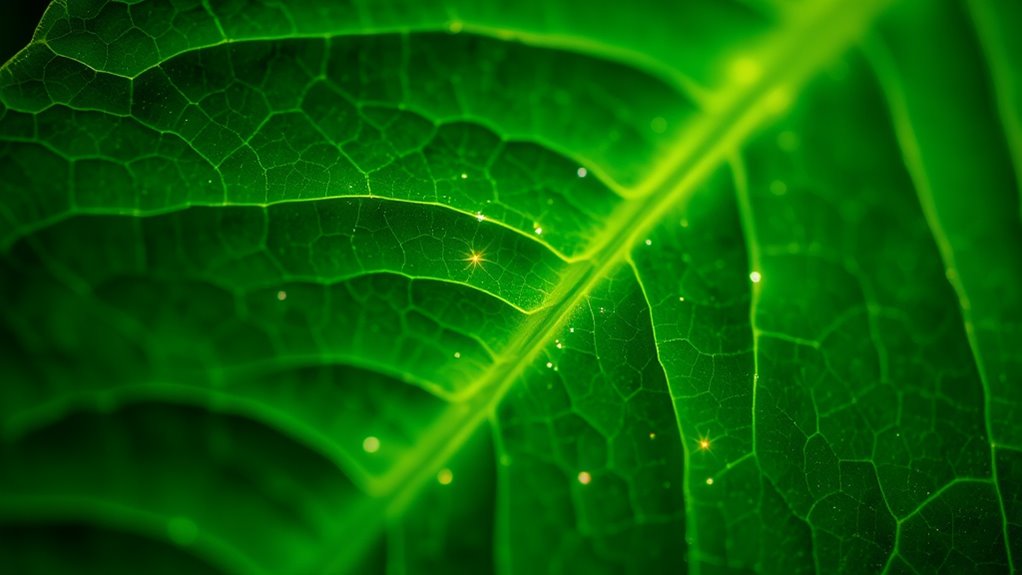
Biophotons help plants communicate by transmitting signals that coordinate growth and responses to their environment. You can observe how they act as stress indicators, revealing when plants are under threat or strain. Understanding these roles can also show you how biophotons contribute to strengthening plant resilience against challenges. Additionally, the ability of plants to detect and respond to biophoton emissions is linked to their overall health and bicycle tire longevity in storage. Recognizing the biophoton emission mechanisms involved can deepen our comprehension of plant signaling systems and improve strategies for crop monitoring and protection. Exploring how biophoton emissions correlate with plant stress responses can further enhance our understanding of their crucial functions in plant health. Moreover, recent studies suggest that light emission patterns from leaf surfaces may vary with environmental conditions, providing further insights into plant responses. Advances in AI security technologies could support the development of non-invasive monitoring tools by analyzing biophoton emission data for early stress detection.
Signal Transmission Mechanisms
Although the exact mechanisms remain under investigation, evidence suggests that biophotons play a essential role in how plants communicate and maintain health. They may use photon signaling to transmit information across cells and tissues, leveraging principles like quantum coherence. This process allows biophotons to act as messengers, coordinating responses efficiently. You might imagine:
- Light pulses traveling through plant tissues
- Coherent photon waves facilitating rapid communication
- Signal pathways that respond to environmental changes
- Fine-tuned interactions mediated by quantum effects
These mechanisms could help plants detect stress, optimize growth, and share information internally or with neighboring plants. Understanding quantum coherence in biophoton interactions could further reveal the sophisticated systems underlying plant communication. Additionally, recent studies suggest that environmental factors might influence biophoton emission levels, impacting plant health and resilience. Moreover, the energy transfer capabilities of biophotons might extend beyond communication to support metabolic processes within the plant. For example, environmental stimuli such as light intensity and quality can modulate biophoton emissions, thereby affecting plant responses. Furthermore, emerging research indicates that environmental influences can alter biophoton emission levels, which may serve as indicators of plant stress or vitality. While research continues, current insights point to a system where biophotons enable subtle yet crucial signaling for overall plant health.
Stress Response Indicators
Biophotons serve as essential indicators of stress in plants by emitting specific light patterns when cells encounter environmental challenges. These light emissions signal changes associated with plant immune responses, providing real-time feedback on their health. When a plant faces stress, such as drought, pathogen attack, or physical damage, biophoton emission levels often fluctuate. This helps you detect environmental stress early, allowing for timely intervention. Monitoring biophoton emissions reveals how plants communicate internally and respond to threats. The unique light signatures produced during stress responses reveal how plants communicate internally and respond to threats. Monitoring biophoton emissions offers a non-invasive way to assess plant health and resilience. By understanding these light patterns, you gain insight into the plant’s ability to detect and react to environmental stress, making biophotons valuable tools in plant health monitoring. Incorporating biodiversity-friendly practices in plant care can further support their natural stress responses and overall vitality.
Enhancing Plant Resilience
By facilitating rapid and precise communication between plant cells, biophoton emissions play a pivotal role in enhancing plant resilience. They enable plants to detect stress signals early, triggering protective responses. Through leaf fluorescence, these light emissions reveal the plant’s health status, guiding interventions like biophoton therapy to strengthen defenses. Visualize how biophotons:
- Signal impending pathogen attacks, prompting defenses
- Coordinate growth adjustments in response to environmental changes
- Facilitate intra-plant communication for resource allocation
- Support recovery after stress or injury
This natural light communication system boosts resilience, ensuring survival. Leveraging knowledge of biophoton emissions allows for innovative strategies to improve plant health, making biophoton therapy a promising tool in sustainable agriculture. Understanding leaf fluorescence helps optimize these approaches for healthier, more resilient plants.
Techniques Used to Study Biophoton Emissions
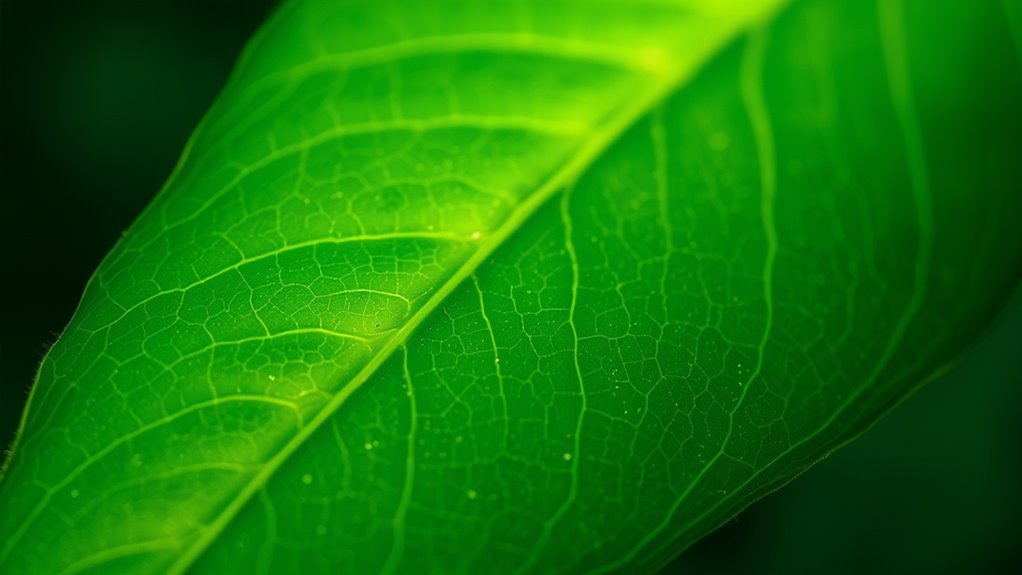
To study biophoton emissions effectively, researchers rely on highly sensitive detection techniques that can capture faint light signals emitted by living organisms. Quantum imaging allows you to visualize biophoton emissions with high spatial resolution, revealing subtle patterns on leaf surfaces. Spectroscopic analysis helps identify the specific wavelengths of emitted light, providing insight into biochemical processes. These methods often use photomultiplier tubes or charge-coupled devices (CCDs) to detect ultra-low light levels.
| Technique | Purpose | Key Feature |
|---|---|---|
| Quantum Imaging | Visualize biophoton spatial patterns | High spatial resolution |
| Spectroscopic Analysis | Analyze light wavelength emissions | Precise wavelength detection |
| Photomultiplier Tubes | Detect faint light signals | Extreme sensitivity |
Implications of Biophoton Research for Ecology and Agriculture

Advances in biophoton research open new avenues for understanding how living organisms interact with their environment. You can now explore how biophoton emissions serve as indicators of plant health, stress, and vigor, offering practical tools for ecology and sustainable farming. These insights enable you to:
- Enhance ecosystem monitoring by tracking biophoton patterns to detect environmental changes
- Improve crop management through early stress detection, reducing chemical use
- Promote sustainable farming by integrating biophoton data to optimize resource use
- Foster biodiversity conservation by observing natural emission fluctuations
Future Directions in the Study of Plant Light Emissions
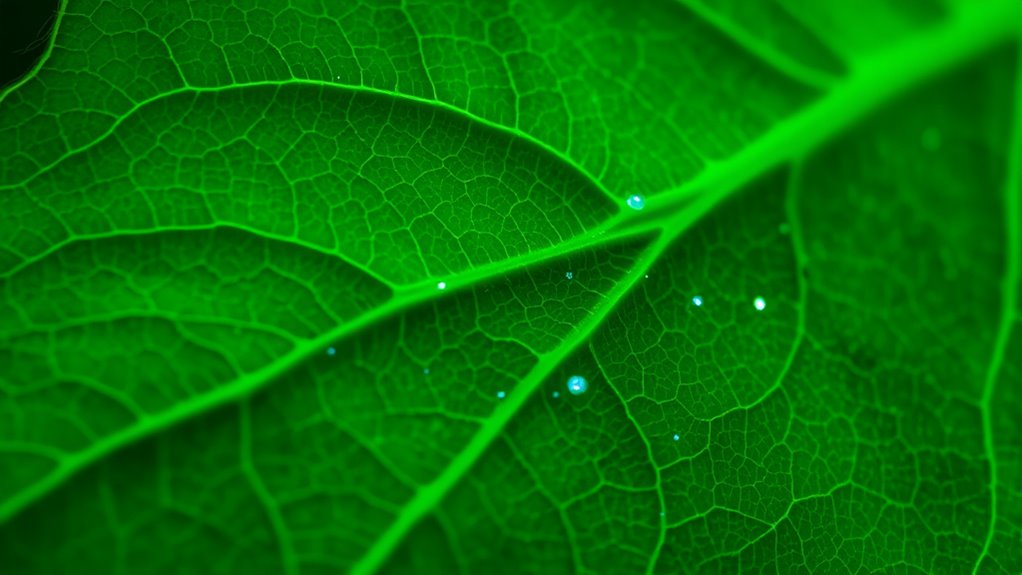
The future of plant light emission research holds exciting possibilities as technology continues to evolve. Advances in quantum biology will deepen your understanding of how biophotons influence plant communication and energy transfer. Researchers will increasingly rely on bioinformatics modeling to analyze complex biophoton data, revealing patterns and mechanisms previously hidden. You can expect interdisciplinary approaches that combine quantum physics, biology, and computational tools, enabling precise predictions of plant light behaviors under various conditions. These innovations will help you decipher new insights into plant health, stress responses, and ecological interactions. As instrumentation becomes more sensitive and data analysis more sophisticated, your ability to explore biophoton emissions will expand, paving the way for breakthroughs in agricultural optimization and environmental monitoring.
Frequently Asked Questions
Can Biophoton Emissions Be Used for Early Plant Disease Detection?
You can use biophoton imaging to detect plant diseases early by identifying specific disease biomarkers that emit distinct light signals. This non-invasive technique allows you to monitor subtle changes in biophoton emissions, which often precede visible symptoms. By analyzing these light patterns, you can catch infections at an early stage, enabling timely intervention and better crop management, ultimately improving plant health and yield.
Do Biophoton Levels Vary With Environmental Stress Factors?
Imagine a lighthouse flickering in a storm—your plants’ biophoton emissions do the same under environmental stress. Yes, biophoton fluctuations increase when stress factors like drought, pollution, or extreme temperatures hit. These variations act as subtle signals, revealing how your plants react to their environment. Monitoring biophoton levels helps you understand stress responses, allowing you to take timely action and keep your plants healthy despite challenging conditions.
Are Biophotons Involved in Plant Responses to Climate Change?
You might wonder if biophotons play a role in how plants respond to climate change. They could be involved in plant communication, acting as photon signaling mechanisms to coordinate responses to environmental shifts. As climate factors alter, plants may use biophoton emissions to detect stress and trigger adaptive responses. Understanding this could reveal new insights into plant resilience and help develop strategies for supporting plant health amid changing conditions.
How Do Biophotons Influence Plant-Microbe Interactions?
You might wonder how biophotons influence plant-microbe interactions. Biophotons play a role in plant signaling by transmitting light signals that microbes can detect, facilitating microbial communication. This light-based signaling helps plants coordinate responses and attract beneficial microbes or defend against pathogens. By understanding this, you can see how biophoton emissions serve as a subtle yet essential communication channel, enhancing the symbiotic relationships that support plant health and growth.
Can Humans Perceive or Utilize Biophoton Emissions for Health?
Imagine Sherlock Holmes peering through his magnifying glass—now, you might wonder if humans can perceive biophoton emissions. While your natural visual perception can’t detect these faint light particles, scientists explore biophoton therapy, using controlled light emissions to promote health. Though you can’t see biophotons, their potential for healing is promising, and future technologies could help you harness this subtle energy for well-being.
Conclusion
So, after all this talk about plant biophotons, it’s almost amusing how we’ve overlooked the silent glow of leaves—nature’s subtle signals. While we chase high-tech solutions, these tiny lights quietly communicate and influence ecosystems. Maybe, in our quest for progress, we should’ve been paying more attention to what plants have been quietly telling us all along. Ironically, it’s their faint glow that might hold the key to our future sustainability.



